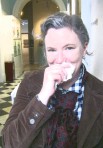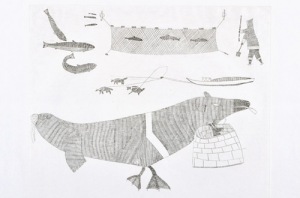
A quick Google search will give you the definition and origin of the word landscape. A Middle Dutch word born out of putting the word land with ship (the figurative use of the word as in ‘condition’) and evolving into what we would now describe as an area of land or a depiction of a region of the natural world. Ultimately the word is now associated with paintings that illuminate geography, mostly those done by artists in the 19th and early 20th century. And, for better or worse it also makes a lot of people think of images of trees, mountains and lakes.
I was at a conference last year when I happened to sit in on a presentation by a group of people who suggested that landscape painters were actually a patriarchal problem that eschewed depicting Aboriginal people because they were for the most part racist. That anyone drawn to work about the natural world without Inuit or Aboriginal people in it was in denial of colonialism’s ruinous history. I was deeply offended however I don’t get publicly offended that often and these people were nice and young so I let it pass. But, I am an artist dedicated to depicting the natural world and I have spent two decades theorizing on it, philosophizing about it and basically creating what would amount to Phd on the subject via the hundreds of books/essays I’ve read and the thousands of hours I’ve spent in the wilderness. I actually moved into the forest to be embedded in my subject matter.
Regardless this opinion, that landscape art work is ultimately just a rouse to push a white, racist agenda regarding the natural world is just that, an opinion. It’s a theory as good or bad as any other and as it might slowly gain traction in Canada, you will no doubt read more and more about this nasty practice of spending time outdoors, soaking up the Earth’s bounty and interpreting it with oil and acrylic on canvas and wood.
At one time the only threat I had to the intellectual rigour of my work was by hobby painters or those that assumed that landscape painting was a hobby art. When I told some people I created landscape art work they would immediately say they did too and would regale me with tales of how once or twice a year they would sit in their backyard and paint their peonies. If I told other artists they assumed that I sell poppy paintings on Etsy. If I told curators they’d roll their eyes and then politely say that they have storage areas full of paintings of lakes. And then there were members of my art community who would discuss on social media at length how sick and tired they were of the Group of Seven and aren’t we as a nation over this whole ‘our wilderness is amazing’ thing? Over time I disengaged with people about what I do because it became harder and harder to describe as I was steadily pushed into a defensive position. I honestly think the worst thing an artist can do is defend what they do. I will never defend what I do as my art work isn’t for anybody but me and those who are drawn to it.

Although I find this ongoing negation of what I have chosen as subject matter (just try getting a grant with a description of wanting to make art about Lake Superior Provincial Park) depressing it’s more like a ‘I know I’m going to die one day’ kind of depressing. Because when I get out and find what I want to paint I care less about the world I will ultimately need to navigate and count on for income and more on what is in front of me, beneath me and part of me. I generally live in the present and find that the administrative tasks that put food on my table a necessary evil and so I’m very happy when I am working.
Therefore I have no need to go on Facebook or Twitter and make statements like, “landscape painting is akin to medieval religious painting with the land as god and not unlike the pagan tradition” or “landscape art work has radicalized footprints which can be seen in Breughel for instance as a way of making the church look inferior/secondary to nature” or that “landscape artists put human influence having a central role in the natural world’s degradation/evolution like Turner’s later work” or that “Courbet showed a defiant sexuality through landscape” or that “resource based industry was widely documented through landscape painting” or that “a lot of landscape work influenced what we have now as the modern environmental movement” or….. as you can see I would spend all my time “defending” landscape work and I don’t do that.
My first experience with landscape art work was with Inuit drawing. My mother loved art work made by Inuit artists, volunteered for Inuit issues and longed to visit what is now Nunavut. These art works told a story of people completely immersed in their landscape, and the need to heed to it, to revere it and to ultimately see their dependence on it as deeply spiritual without the dualism (humans/nature) we seem to have and continue to have. I am forever grateful that I was given this opportunity to explore 2D work that was so rich in poetic and philosophical underpinnings while also being narratives – in many ways this is still what I try to do.
But I don’t draw people or animals and I never will. I am the figure in my landscape paintings. Like landscape artists before me I just try to pull into my psyche who I am in the wilderness; I’m not an intruder, I’m not a tourist, I’m not in denial of shared histories, I hold the wild in me and I interpret this experience in art, nothing more.
